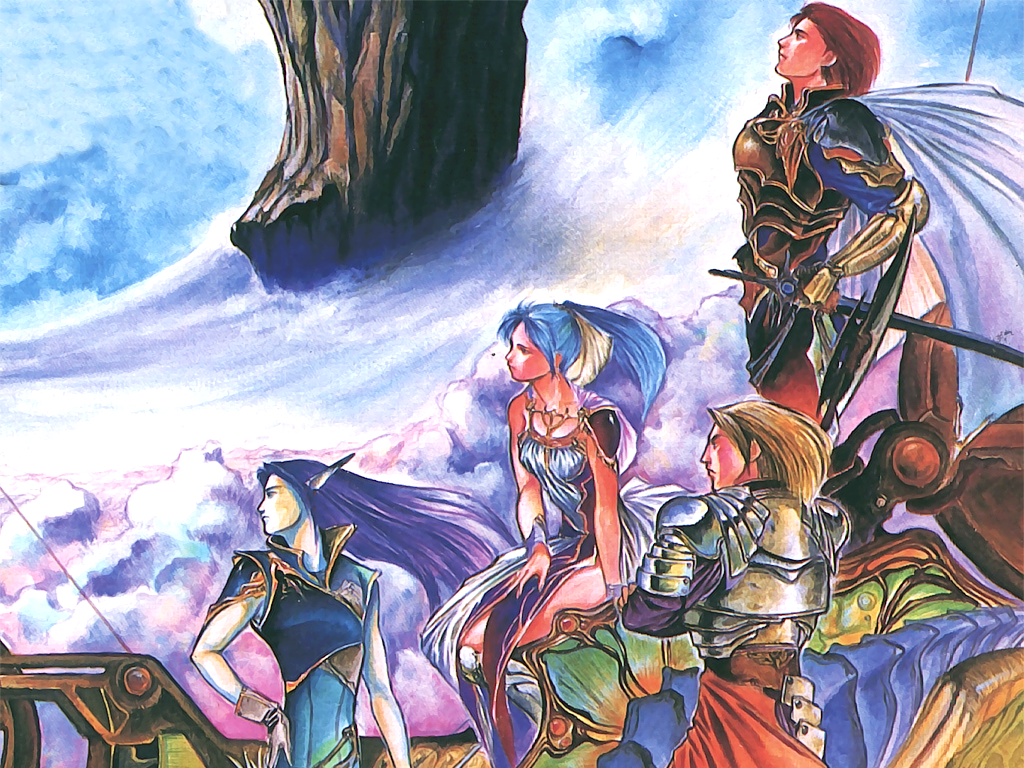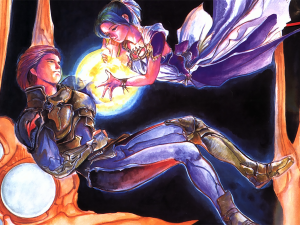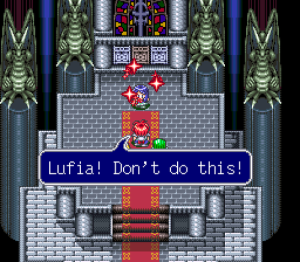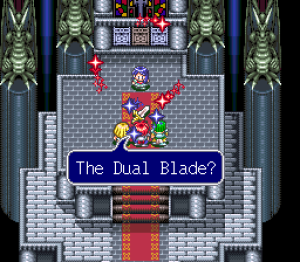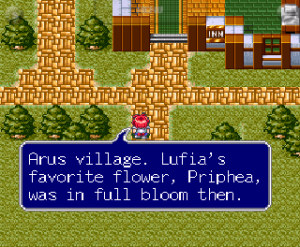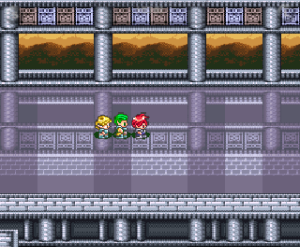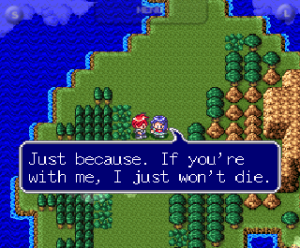Last updated on April 2, 2013
Yet another Wild Author appears!
Eun Woo Chung, who I have never met in real life (must be the ocean between us), currently works in the South Korean Army. However, his true passion comes from observing and criticizing video games as a form of “digital literature”. His Korean blog, Games Literature Museum, discusses these issues at length, but as far as I know he hasn’t written anything in English…until now. Theology Gaming’s proud to add him among our number, and his series Video Game Explications. This entry and series was a long time in coming (and he took time out of an extremely busy schedule to write it), so I hope you enjoy Video Game Explications and more articles in the future from Mr. Chung!
Zachery Oliver, Editor in Chief
———————————————————————————————————————————————————————————————————————–
*major spoilers ahead*
Her name is Lufia.
I met her as a child.
We grew up together in Alekia, a remote village hidden in the depths of the Northern Mountains.
Each year, at the dawn of Spring, Priphea flowers would be in full bloom near the outskirts of the village. It’s Lufia’s favorite flower. I used to sit by the flowerbeds and watch her dance, and with every graceful movement I could catch the whiff of the flower’s scent. Her long hair was blue as the surface of a flowing river in the brightest moment of the day, dancing along with the wind. I dreamed those days would last forever.
I think I always knew, but did not realize until now. She has become, slowly but powerfully, the reason for my journey.
Her name is also Erim.
“Hold your sword, Lars.”
Lufia’s eyes were firm and unrelenting, fixed upon Lars.
“Lufia, I can’t.”
“Lars, just as the Sinistrals are your enemies, those with Maxim’s blood are mine.”
“Hold your sword and finish this.”
Lars knelt down. His blade was tucked into its sheath, just as unrelenting as Lufia’s stern voice. The battle has made him weary, but he wasn’t without strength. It was her voice that he could not bear. Her soft voice, the same voice that soothed him in the darkest hours of his life, was determined to wage war against him.
“I am the Sinistral Erim.”
Lufia stood up, walking toward the throne of the floating fortress. Without showing her face, she took a deep breath, and cried out her last wish.
“Lars! Destroy me!”
It was then when the Dual Blade trembled within its sheath, breaking its shell and rising above the great halls. The blade, as much as it was trembling with profuse power, was emitting a brilliant ray of light.
“The Dual Blade?”
The blade pointed itself to Lufia, and before Lars could open his eyes from its brilliant radiance, it flew across the hall toward Lufia.
Lufia: The Fortress of Doom has become somewhat of a cult classic among Super Nintendo RPGs. It doesn’t enjoy the same level of recognition as better known tiles such as Chrono Trigger and Final Fantasy VI, but it has a decent enough following among North American gamers because it is one of the few NA-released RPGs in the early SNES era.
Honestly, the game as a whole doesn’t offer the most pleasant experience. The difficulty is outrageous, absolutely requireing heavy grinding for the gamer to reach even the slightest degree of competency to beat the game. Unless one has an extra 10 hours to spare just to fight the same banal enemies time after time, Lufia would be a hard game to enjoy. Behind this faulty mechanism lies a wonderful jewel that is quite uncommon to see in the early SNES era. There is a heartfelt narrative about love and sacrifice that is decent enough to offer a memorable emotional experience to gamers who are willing to put up with the senseless grinding (Editor’s Note: Probably me!)
I was pleasantly surprised to see the theme of love and sacrifice unwind in an old and obscure Super Nintendo RPG, and the concept of having to kill your own loved one for the sake of the world was a fascinating narrative turn. Lufia and Lars were childhood friends who decided to go on a journey together to destroy the evil Sinistrals who were threatening their world. As it turns out, the Sinistrals have a blood pact with each other: so long as the Sinistral of Death, Erim, is alive, the other Sinistrals can be reborn to threaten the world once more.
Lars happens to be a descendant of the hero Maxim, who was the first human hero to destroy the Sinistrals a hundred years ago before the events of the game. However, the Sinistral Erim was not completely destroyed. She was reincarnated as a little innocent girl who does not know she is to be the key to the resurrection of the other Sinistrals. That girl is Lufia.
Lars and Lufia, therefore, are mortal enemies bound by destiny. Lars is destined to destroy the Sinistrals, whereas Lufia is destined to awaken the death and destruction of the world. The love story between the two reminds you of the ill-fated romance of Romeo and Juliet, except Juliet isn’t the goddess of death. When Lufia realizes she was the Sinistral Erim all along, she overcomes the memories of Erim with her love for Lars. Wiith her last remaining willpower, she asks Lars to kill her with his blade. Lars cannot bring himself to do it, but somehow the blade responds to Lufia’s sacrificial call and strikes her without its owner’s permission.
However, the most powerful moment of this story reveals itself at the epilogue of the game, long after the Dual Blade strikes Lufia and Lars decides to travel the world aimlessly lamenting his loss love.
It’s been six or seven months. The only thing Lars could do is continue his journey. Each step he took was a tribute to her.
Every village he stopped by reminded him of the time he visited with Lufia. Whenever his acquaintances would ask about her, he would be silent, making his best effort to draw a faint grin. Even the laughter of the children was a dirge upon his soul.
He finally arrived in the Southern Islands, the last place he visited with Lufia. The Priphea were in full bloom in the village of Arus. It was an amazing sight to behold.
Lars saw, in the middle of the many flowerbeds, a girl with cerulean blue hair. That color that immediately shook his heart. He was frozen in his place, fixing his gaze on this girl who was dancing in circles.
The girl soon noticed the stranger who was giving her a puzzled stare. She nonchalantly marched toward the man with a smile of an innocent child.
“Hello. Are you a traveler?”
Lars knew this voice. It was her voice. But what trembled his heart so feverishly was the fact that he knew this face. This person. This was Lufia!
“Excuse me, but may I ask your name?” Lars asked.
The girl with the blue hair smiled again. She came a little closer to Lars, and told him the most incredible thing he had ever heard in his life.
“My name is Lufia.”
The story of Lufia: The Fortress of Doom is a rather uncommon one in its genre, especially considering the time it was released. Many hero-centric adventure stories in that time that were marketed for children had a simple good versus evil framework that ended with the demise of the big bad boss. Same goes for the early Dragon Quest series and Final Fantasy series, both of which greatly influenced Lufia. However, in Lufia the journey does not end with the hero simply vanquishing the evil force that threatens his world. It takes one extra step beyond that. The evil force is redeemed.
At the end of Lufia: The Fortress of Doom, we follow the last aimless journey of the hero to a remote village that he once visited with his comrades. At this point, our hearts are already crushed. The main character’s one true love turned out to be the goddess of death, and through her awakening that was only possible because of the love she shared with the hero, she accepts her own destruction to bring peace to the world.
Her last words are painfully engraved in our minds.
“Lars. I was much happier in the short time I lived as Lufia than the eternity I spent as Erim.”
But we meet her again. She seems different, though. She doesn’t retain her memory of Lars. She doesn’t seem to know she is the Sinistral of Death who helped the hero defeat the three most terrible forces of evil the world has ever seen. Also, she seem to be perfectly fine considering the fact that she was struck by a divine blade and fell into the pit of abyss.
What happened?
The elder of the Tower of Grief, who was the one that found Lufia near the shore, gives us some clues as to what really happened. “Maybe it’s because of the Dual Blade” he says, “its great power affects people in different ways. The blade’s energy changed Lufia“.
Something in Lufia changed when the Dual Blade struck her. Perhaps what the holy blade actually struck wasn’t Lufia, but the evil inside of her. Maybe it was Erim, not Lufia, who died in that event.
Therefore, if anyone is in Christ, he is a new creation. The old has passed away; behold, the new has come.
2 Corinthians 5:17
We all have an “Erim” in us. I’m not saying we have an unawakened Goddess of Death waiting for its time to shine, but we have an evil nature that was embedded in us since the dawn of man. It is sin, and because of that sin we are eternally separated from God – we are effectively and decisively damned. However, God decided to deliver us from that eternal damnation. Only by sending His own son Jesus Christ to die for us, our sinful self became an “old”, “passed away” self, effectively and decisively killed (Romans 6:6). It frees us from the slavery of evil. This is redemption. The Erim in us died.
Lufia: The Fortress of Doom reminded me of this amazing act of love by God/ The transformation from evil to good, the Dual Blade striking Erim within Lufia so that Lufia could finally be free and redeemed from her evil self and her damned destiny: It was a powerful moment for me.
I am not sure if the writer for this game wrote this with a theological intention. I would guess that he/she probably didn’t. However he wrote a story that immersed me, and through the story elements and progression I was able to see glimpses of God’s truth that spoke clearly and powerfully. Moments like this are part of the reason why I play games. I have high hopes for the power of video game narratives, and I believe with amazing stories that capture the emotional investment of gamers, we can speak powerful truths of God.

